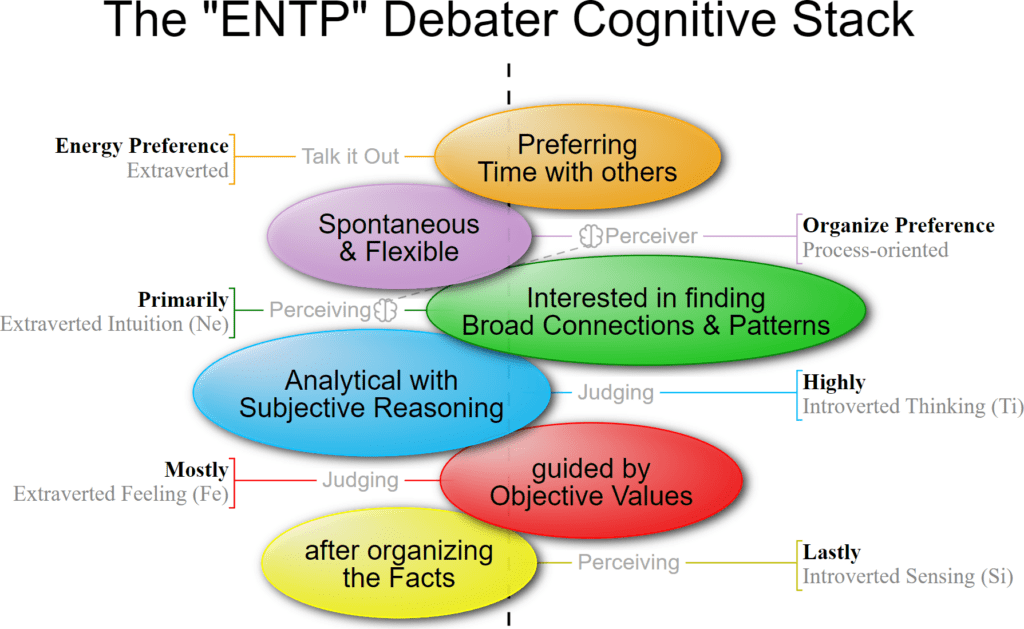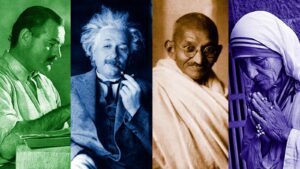What is the Keirsey ENTP “Inventor” Personality Type?
The Keirsey ENTP “Inventor” Personality Type is a Rational Temperament with an Abstract Communication Style and a Utilitarian Action Style.
Keirsey organized the Four Temperaments as a matrix. There are two communication styles, abstract and Concrete, similar to the Myers-Briggs Intuition (Abstract) and Sensing (Concrete) “Perceiving” Cognitive Functions.
And by two action styles: cooperative and utilitarian. Utilitarian people, for the most part, do what works, while Cooperative people do what’s right.
Keirsey named the Four Temperaments as suggested by Plato: Artisan (Iconic), Guardian (Pistic), Idealist (Noetic), and Rational (Dianoetic).

Concrete versus Abstract Communication Style
Keirsey divided the Four Temperaments into two Communication Styles: Abstract and Concrete. These styles resemble the Myers-Briggs Intuition and Sensing “Perceiving” Cognitive Functions.
Some people talk primarily about everyday reality’s external, concrete world: facts and figures, work and play, home and family, news, sports, and weather—all the who, what, when, where, and how of life.
Other people talk primarily about the internal, abstract world of ideas: theories and conjectures, dreams and philosophies, beliefs and fantasies—all the whys, ifs, and what might be of life.
Concrete people talk about reality daily, while Abstract people talk about ideas.
According to Keirsey, everyone can engage in both observation and introspection. People are observant when they touch objects or otherwise perceive the world through their five senses. When people reflect and focus on their internal world, they are introspective. However, individuals cannot engage in observation and introspection at the same time. The extent to which people are more observant or reflective affects their behavior.
People who are generally observant are more ‘down to earth.’ They are more concrete in their worldview and focus on practical matters such as food, shelter, and their immediate relationships. Carl Jung used the word sensation when describing people who prefer concrete perception.
Generally, reflective people have more ‘heads in the clouds’ and abstract worldviews. They focus on global or theoretical issues such as equality or engineering. Carl Jung used the word intuition to describe people who prefer abstract perception.
Cooperative versus Utilitarian Action Style
Some people act primarily practically or pragmatically; that is, they do what gets results, what achieves their objectives as effectively or efficiently as possible. They only check afterward to see if they observe the rules or go through the proper channels.
Other people act primarily cooperatively or socially acceptable; they try to do the right thing in keeping with agreed-upon social rules, conventions, and codes of conduct. Only later do they concern themselves with the effectiveness of their actions.
These two ways of acting can certainly overlap, but as they lead their lives, practical people mostly do what works, while cooperative people do what’s right.
Keirsey compares the differing temperaments with cooperative (Complying) and pragmatic (Adaptive) temperaments. Cooperative people pay more attention to other people’s opinions and are more concerned with doing the right thing. Sensible people (Utilitarian) pay more attention to their thoughts or feelings and are more concerned with doing what works. No comparable idea in the MBTI or Jung corresponds to this dichotomy, which is a significant difference between Keirsey’s work and Myers and Jung’s.
The pragmatic temperaments are Rational (pragmatic and abstract) and artisan (Pragmatic and concrete). The Cooperative Temperaments are Idealists (Cooperative and Abstract) and Guardians (Cooperative and Concrete). Neither the MBTI nor Jung included the concept of Temperament in their work.
ENTP Keirsey/MBTI Correlation
| Keirsey | MBTI | |
|---|---|---|
| E | Attentive Role Variant | Extraverted Intuition |
| N | Abstract Communication Style | Extraverted iNtuition Dominate Function |
| T | Utilitarian Action Style | Auxiliary Introverted Thinking Function |
| P | Informative Role | Thinking is a Perceiving Function |
With Extraverted Intuition as the first Dominant Function and Extraverted Thinking as the second Auxiliary Function, the MBTI ENTP “Debater” Personality Type sorts to the Keirsey ENTP “Inventor” Personality Type.

ENTP Personality Type cross-reference
- Temperament Type – Choleric
- Animal Type – Lion
- DISC Type – Dominant
- Socio-Communicative Type – Driver
- True Colors – Green
- Color Code – Red
- Personality Compass – North
- Occupational Type – Enterprising
- Learning Type – Activist
- Leadership Type – Dominator
Enneagram Types
Inventor Personality Characteristics
Inventors begin building gadgets and mechanisms as young children and never really stop, though as adults, they will turn their inventiveness to many kinds of organizations, social and mechanical.
There aren’t many Inventors, say about two percent of the population, but they significantly impact our everyday lives.
With their innovative, entrepreneurial spirit, Inventors always look for a better way, eyeing new projects, enterprises, and processes. Always aiming to “build a better mousetrap.”
Inventors are keenly pragmatic and often become experts at devising the most effective means to accomplish their ends.
Inventors are the most reluctant to do things in a particular manner just because that’s how they’re done. As a result, they often bring fresh, new approaches to their work and play.
They are intensely curious and continuously probe for possibilities, especially when trying to solve complex problems.
Inventors are filled with ideas but value them only when they are practical. They see product design not as an end but as a means to an end—a way of devising a prototype that can be brought to market.
Inventors are confident in their pragmatism, counting on their ability to find effective ways and means when needed rather than making a detailed blueprint in advance.
A rough idea is all they need to feel ready to proceed into action.
Inventors often have a lively circle of friends and are interested in their ideas and activities.
They are usually easy-going, seldom critical, or caring. Inventors can be engaging conversationalists, able to express their complicated ideas and follow others’ opinions.
When arguing issues, however, they may deliberately employ debate skills to the severe disadvantage of their opponents.
Inventors are usually non-conformists and can succeed in many areas if the job does not involve too much humdrum routine.
They make good leaders on pilot projects that test their ingenuity. And they are skilled at engineering human relationships and human systems, quickly grasping the politics of institutions and always wanting to understand the people within the system rather than tell them what to do.
No matter what their occupation, however, Inventors display an extraordinary talent for rising to the demands of even the most impossible situations.
Famous Inventors
Walt Disney, Benjamin Franklin, Ray Kurtzweil, Buckminster Fuller, Richard Feynman, Thomas Edison, Camille Paglia, and Nicola Tesla are examples of inventors with rational tempers.

What are the Keirsy Personality Temerpaments?

David Keirsey, born in 1921, was an American psychologist specializing in conflict management and family counseling. He began researching human behavior and Personality in the 1940s.
Keirsey blended the Myers-Briggs Personality Types with Ernst Kretschmer’s model of the Four Temperaments, developing the Keirsey Temperament Sorter, which was made famous by his book “Please Understand Me.”
Instead of using the term Personality, Keirsey used Temperament. He viewed it as a configuration of observable Personality Traits, communication habits, patterns of action, characteristic attitudes, values, and talents. To Keirsy, Temperament encompasses personal needs, individual contributions, workplace contributions, and societal roles.
Keirsey correlated the sixteen MBTI Personality Types into Four Te peraments. He divided each Temperament into two Roles: informative and Directive. He subdivided the roles into expressive (extraverted) and attentive (introverted) role Variables.
Informative versus Directive Roles
Keirsey distinguishes between people who generally communicate by informing others versus those who speak by directing others. This distinction subdivides each of the four Temperaments into eight Roles.
Expressive versus Attentive Role Variants
Individuals who act before observing are expressive. In contrast, people who follow before working are Attentive.
Expressive and attentive variants further subdivide the eight roles into 16 types correlating to the 16 Myers-Briggs personality types.


